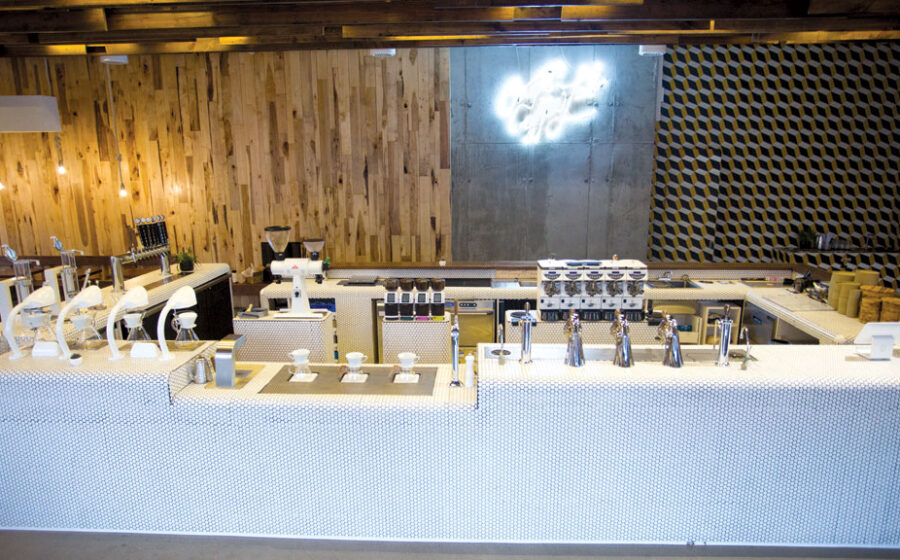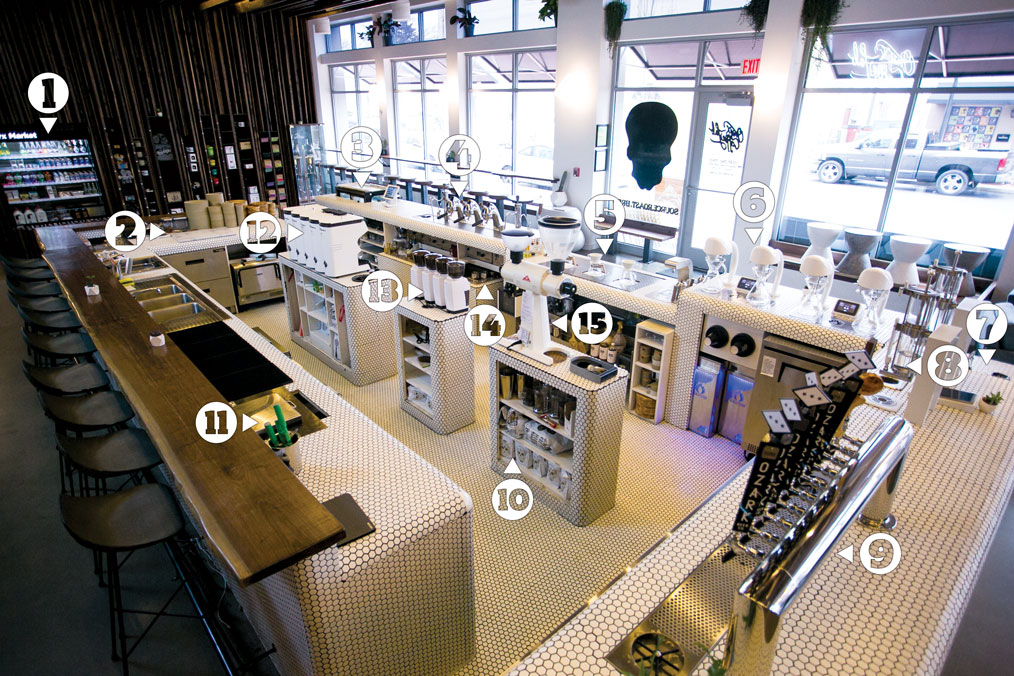[W]hen Jon and Andrea Allen, the owners of Onyx Coffee Lab in northwest Arkansas, began designing this bar, they didn’t have a building to put it in. They didn’t really even have a plan for a new shop. But they knew what did and did not work at their two other cafés, and so they began to plan what they’d do next.
First, they’d make the space radically open, offering the baristas no place to hide, or, put more positively, they’d give them the chance to perform. “We wanted to showcase the baristas, almost as a stage,” Jon says. “For people to take coffee seriously, they need to see the work that goes into it. . . . People will order a latte, and they’ve ordered lattes for thirty years, and they don’t know how it’s made. They think there’s a box and someone pushes a button and a latte is made.” With under-counter equipment—a Modbar espresso machine, four Curtis Seraphim brewers, and a Marco Über water boiler—there’s little to block customers’ views.
Both Allens have worked in coffee shops for a long time, and one part of bar design, especially in busy shops, always bothered Jon: baristas up in each other’s spaces. “You have to go north, south, east, and west to make a drink, and you bump into everyone else, and you have 180-degree drinks that spill everywhere,” he says, almost as if describing a recurring nightmare. At the new bar, baristas would move along one plane, north and south. The barista on espresso would never need to leave her station, and even if a second barista joined the station, they’d never cross one another because they’d each have a grinder with the house blend; the barista on pour-overs and iced drinks would have his own grinders, enough to dial in multiple single-origins; and the person making batch brews and tea and pouring beer would have their own grinder and bean supply, too.
“This gives them more of a sense of artistry and purpose. This is their station and their grinder. There is controlled freedom, and I think that is empowering to the barista,” Jon says. And if that seems too airy, he also says, “It becomes really efficient. It’s probably our fastest shop.”
When they did build this long-planned café in a new building in Bentonville, they didn’t hold back. Maybe they even went for overkill. Jon sees that, but says it solves a problem he had at his other shops. Onyx creates some of the wildest drinks in coffee and sometimes they require dedicated tools, things that normally don’t have a place in the shop, like blow torches. At this new café, there’s room for those things. There’s room to plan what the shop will look like, and serve, in two-years’ time.
1. The Market: The cold case is filled with local items including milk, artisan soda, yogurts, bean-to-bar chocolates, cheese, and even produce. “If you wanted to recreate anything we make, chances are everything you need is in that display,” says co-owner Jon Allen.
2. The Kitchen: Onyx limits their non-pastry food items to quiches and toasts, which are warmed in a Turbochef oven. In the mornings, they also serve breakfast tacos from a neighboring restaurant.
3. Macaron Mania: Customers ordering drinks at the POS are ambushed by a pastry case filled with macaron. “We sell like 2,000 macarons every week,” says Allen. “It’s insane.”
4. Down Below: Allen believes this café requires the under-counter setup of the Modbar. “Conceptually, none of it would end up working” without it, he says. At peak hours two baristas are on the machine.
5. Cocktails and Pour-overs: The entire counter at this station is a drain. After brewing, the Kalita Waves, which are set atop built-in scales, are simply set on the counter to drain. Hot water is supplied by a Marco Über boiler. An array of cocktail ingredients and barwares allow the two baristas at this station to make Onyx’s signature drinks.
6. Four Angels of Brewing: The four Curtis Seraphim brew batches of Onyx’s Sugar Skull batch blend. “We chose the Seraphim because they are very nice for keeping your volume accurate,” Allen says. “You’re not brewing these big half-gallon or gallon pots and then throwing half it out.”
7. Condiments: Set at waist height for customers, the condiment station offers milk, honey, syrups, lids, and napkins.
8. A Fourth Brew Station: The pair of Alpha Dominche Steampunks is used to brew tea and whichever premier coffee, like a geisha, the café is featuring.
9. Tap Lineup: “We do beer, yay!” says Allen. There are eight taps, including their nitro cold-brew and an IPA made with their cold-brew. The other six taps are devoted to Ozark Beer Company.
10. Bean Storage: The back of each grinder station holds the beans for its grinders. At the espresso station, five columns of shelves correspond to the beans used in the five grinders above.
11. Clean Up and Ice Cream: The back bar holds a sink, dish washer, and cleaning supplies. It also has a fridge for the ice cream used in the Onyx shake.
12. Grinder Station One: Count ’em: five Nuova Simonnelli Mythos grinders. Each outside grinder holds Ozark Copper, the house blend, so both baristas have their own. The other grinders contain decaf and single-origins.
13. Grinder Station Two: Four Baratza Forte grinders hold one decaf single-origin and three seasonal single-origins.
14. The Trough: Eschewing a standard fridge, Onyx uses a refrigerated banquet trough. “You can look down and reach down without bending over,” says Allen.
15. Grinder Station Three: The double Mahlkönig EK 43 devotes one side to the Sugar Skull that feeds the Seraphim, while the other side is for the Steampunk’s special.
—Cory Eldridge is Fresh Cup’s editor.

















